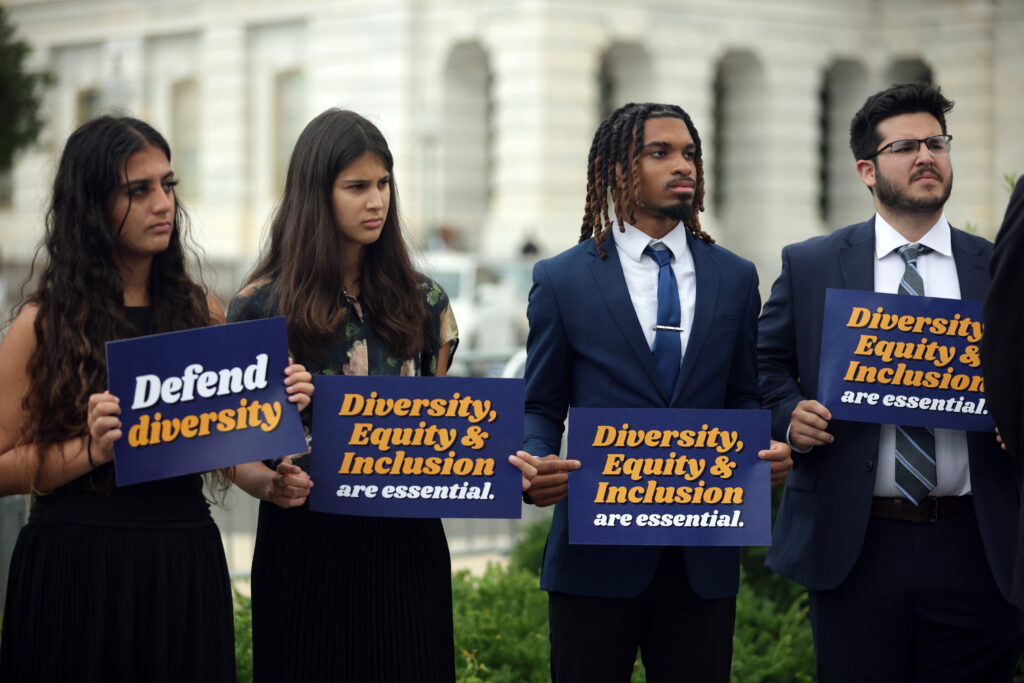🔴 Website 👉 https://u-s-news.com/
Telegram 👉 https://t.me/usnewscom_channel
President Donald Trump’s executive orders banning diversity, equity and inclusion-related racial and gender preferencing have ostensibly doomed the DEI industry.
But DEI was already on its last legs.
Half of all Americans no longer approve of racial, ethnic or gender preferences.
DEI had enjoyed a surge following the death of George Floyd and the subsequent 120 days of nonstop rioting, arson, assaults, killings and attacks on law enforcement during the summer of 2020.
In those chaotic years, DEI was seen as the answer to racial tensions.
DEI had insidiously replaced the old notion of affirmative action — a 1960s-era government remedy for historical prejudices against black Americans, from the legacy of slavery to Jim Crow segregation.
But during the Obama era, “diversity” superseded affirmative action by offering preferences to many groups well beyond black Americans.
Quite abruptly, Americans began talking in Marxist binaries.
On one side were the supposed 65 to 70% white majority “oppressors” and “victimizers” — often stereotyped as exuding “white privilege,” “white supremacy” or even “white rage.”
They were juxtaposed to the 30 to 35% of “diverse” Americans, the so-called “oppressed” and “victimized.”
Yet almost immediately, contradictions and hypocrisies undermined DEI.
First, how does one define “diverse” in an increasingly multiracial, intermarried, assimilated and integrated society?
DNA badges? The old one-drop rule of the antebellum South? Superficial appearance?
To establish racial or ethnic proof of being one-sixteenth, one-fourth, or one-half “non-white,” employers, corporations and universities would have to become racially obsessed genealogists.
Yet refusing to become racial auditors also would allow racial and ethnic fraudsters — like Sen. Elizabeth Warren and the would-be mayor of New York, Zohran Mamdani — to go unchecked.
Warren falsely claimed Native American heritage to leverage a Harvard professorship.
Mamdani, an immigrant son of wealthy Indian immigrants from Uganda, tried to game his way into college by claiming he was African American.
Second, in 21st-century America, class became increasingly divergent from race.
Mamdani, who promises to tax “affluent” and “whiter” neighborhoods at higher rates, is himself the child of Indian immigrants, the most affluent ethnic group in America.
Why would the children of Barack Obama, Joy Reid or LeBron James need any special preferences, given the multimillionaire status of their parents?
In other words, one’s superficial appearance no longer necessarily determines one’s income or wealth, nor defines “privilege” or lack thereof.
Third, DEI is often tied to questions of “reparations.” The current white majority supposedly owes other particular groups financial or entitlement compensation for the sins of the past.
Yet in today’s multiracial and multiethnic society, in which over 50 million residents were not born in the United States and many have only recently arrived, what are the particular historical or past grievances that would earn anyone special treatment?
What injustices can recent arrivals from southern Mexico, South Korea or Chad claim, knowing little about, and experiencing no firsthand bias from, Americans, the United States, or its history?
Is the DEI logic that when a Guatemalan steps one foot across the southern border, she is suddenly classified as a victim of white oppression and therefore entitled to preferences in hiring or employment?
Fourth, does the word “minority” still carry any currency?
In today’s California, the demography breaks down as 40% Latino, 34% white, 16% Asian American or Pacific Islander, 6% black, and 3% Other — with no significant majority and fewer whites than the Latino “minority.” Are Latinos the new de facto “majority” and “whites” just one of the four other “minorities?”
Do the other minorities, then, have grievances against Latinos, given that they are the dominant population in the state?
Fifth, when does DEI “proportional representation” apply, and when does it not?
Are whites “overrepresented” among the nation’s university faculties, reportedly 75% white, when they comprise only about 70% of the population?
Or, are whites “underrepresented” as college students, making up just 55% of them, and thus in need of DEI action to bump up their numbers?
Black athletes are vastly overrepresented in lucrative and prestigious professional sports.
To correct such asymmetries, should Asians and Hispanics be given mandated quotas for quarterback or point-guard positions to ensure proper athletic “diversity, equity and inclusion”?
Sixth, DEI determines good and bad prejudices, as well as correct and incorrect biases. “Affinity” segregationist graduations — black, Hispanic, Asian and gay — are considered “affirming”.
But would a similar affinity graduation ceremony for European-Americans or Jews be considered “racist”?
Is a Latino-themed, de facto segregated house on a California campus considered “enlightened,” while a European-American dorm would be condemned as incendiary?
In truth, DEI long ago became corrupt, falling apart under the weight of its own paradoxes and hypocrisies.
It is a perniciously divisive idea — unable to define who qualifies for preference or why, who is overrepresented or not, or when bias is acceptable or unjust.
And it is past time that it goes away.
Victor Davis Hanson is a distinguished fellow of the Center for American Greatness.
